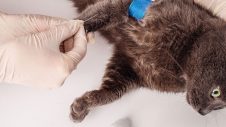Ultrasounds and your pet
Ultrasounds are a safe, non-invasive way to assess your pet’s internal organs in real-time. An ultrasound for a dog or cat may be recommended for various reasons, such as investigating vomiting, diarrhoea, or unexplained weight loss. It can also help detect fluid buildup, internal bleeding, tumours, or cysts. In some cases, ultrasound are used to monitor ongoing conditions like liver or kidney disease.
Ultrasound is also an extremely useful tool for monitoring the heart, especially when assessing conditions such as congestive heart failure. For pets with a suspected heart issue, an ultrasound can give your vet a clearer picture of what’s happening inside the chest and abdomen.
How does ultrasound work on pets?
High frequency sound waves are emitted by an instrument called a ‘transducer’ placed on your pet’s body. These waves are reflected back as echoes from the structures in the body and are picked up by the transducer. A computer converts the echoes into visual patterns which reveal the size, structure, and development of organs. The images are displayed on a television-type monitor during the examination and may be captured electronically as instant pictures or recorded on videotape.
There is little-to-zero discomfort for your animal during these examinations, although areas of hair may have to be clipped and coupling jelly applied between the transducer and your pet’s skin. Sedation or general anaesthesia may be required in some cases, to keep the patient still enough for a detailed examination.
How can an ultrasound help my pet?
Many of the internal organs can be scanned non-invasively including liver, kidneys, bowel, spleen, bladder, prostate, uterus, and heart. Information can be obtained on the size and texture of organs, which aids in the diagnosis of disease.
The ultrasound may also be used to guide a minimally invasive biopsy probe that enables collection of tissue samples without the need for large abdominal incisions. Ultrasounds provide the most reliable form of pregnancy diagnosis for dogs and cats.
Some organs require the expertise and specialised technology of a Veterinary Specialist Ultrasonographer to image and assess. The adrenal glands and pancreas are two organs that may fall into this category.
In addition, Colour Doppler Ultrasound is a technology that allows the measurement of directional blood flow through the heart, as well as blood flow velocity. This information is important in the assessment of some heart defects, especially heart disease of kittens and puppies.
Ultrasounds & Pregnancy
If you’re wondering whether your dog or cat is expecting, a pregnancy ultrasound is the most accurate and stress-free way to confirm. These scans are typically performed around 25–35 days after mating, when the puppies or kittens are large enough to be detected.
Our trained veterinary team uses ultrasound to confirm a pregnancy, monitor foetal development, and even detect heartbeats. It’s a gentle process that’s safe for both mum, pups and kittens, giving you valuable insight into your pet’s health during this special time.
Ultrasound vs. X-ray: What’s the Difference?
While both diagnostic tools are used to look inside the body, they serve different purposes. X-rays are ideal for viewing bones and detecting things like fractures, dental issues, or swallowed objects. Ultrasounds, on the other hand, are better suited to viewing soft tissues and organs like the liver, kidneys, and bladder, as well as blood flow and pregnancies.
If your pet is unwell, your vet may recommend one or both imaging tools to get a clearer understanding of what’s going on. At Greencross Vets, we’re equipped with both digital X-ray and veterinary ultrasound technology to provide the most accurate diagnosis possible.
Contact Us
Think your pet might need an ultrasound? Whether you’re checking on a pregnancy, investigating unusual symptoms, or just want peace of mind, our team is here to help. Contact your local Greencross Vet to book a consultation or learn more about our trusted dog and cat ultrasound services.

 Greencross Vets
Greencross Vets 









